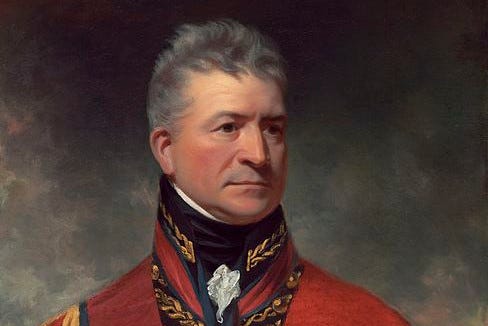Another week, another historic Briton is in trouble. This time the portrait of Thomas Picton, a lieutenant general who died at the Battle of Waterloo, has been temporarily removed from the National Museum Wales until it can be displayed in a manner more to his critics’ tastes. His statue is facing similar trouble.
Picton is variously known as a military hero, the tyrant of Trinidad or “a rough foul-mouthed devil”, to quote his boss the Duke of Wellington. While he has a good reputation for soldiering, he’s also accused of being a beastly colonial governor, backing the slave trade and authorising the torturing of a 14-year-old girl accused of theft.

You know the rest, I guess. Some artists have been given £12,000 to create work focusing on Picton’s victims so the painting can be put in a new context. This will “challenge the colonial narratives that have traditionally existed in National Museum Cardiff’s galleries by centring black consciousness, experiences, and voices”, according to the museum. The rest will be history, from a different point of view.
Removing statues has been a popular public activity since last year, when the toppling of merchant Edward Colston’s statue in Bristol prompted many authorities to hastily denounce or remove their own memorials to wrong’uns. New York City’s council has just voted to remove a statue of Thomas Jefferson, whose role in his country’s independence struggle has not atoned for his slave owning.
One could litigate each case at length based on personal merits. One could equally quibble that people’s behaviour is always in the context of their societies, or parry by arguing that many of these figures were controversial even in their own eras.
Or you could argue, as I’ve done, that monuments tend to be for one aspect of a person’s character rather than their entire legacy. Nelson’s Column, despite Afua Hirsch’s arguments to the contrary, is not a monument to slavery or adultery, but to the admiral’s services against French shipping.
Frankly though, does anybody care about these arguments? A tiny group defend the statues out of thoughtless patriotism, while similar numbers criticise the statues out of thoughtless oikophobia. Such people are passionate.
Nearly everyone else knows nothing about who is being discussed, and cares a little less. I’ve read a dozen Sharpe novels and even I couldn’t recall who Picton was. If you polled the Welsh and residents of Trinidad and Tobago it would be amazing if even 0.1% knew him. Even for big names like Winston Churchill, laughably high proportions of the public don’t know them.
Even if people did know who such people were, why would they care about a portrait squirreled away in a Cardiff museum? Only those who make it their business to be offended by such things, or be offended by the removal of the same. Even the average museum-goer glances at a painting and moves on.
Yet I have an opinion: I like looking at monuments to military men. Should I find out later that this professional killer had some other ethical shortcomings, I will be incredibly unsurprised. But I can enjoy tales of British military derring-do without thinking it was all good, or even for a good cause.
Which is to say my status as an interested tourist gives me as much stake in the outcome as the people who the museum claims to represent, but who actually do not care. Keep the statues and portraits of the blackguards, I say, if only for my own entertainment.



